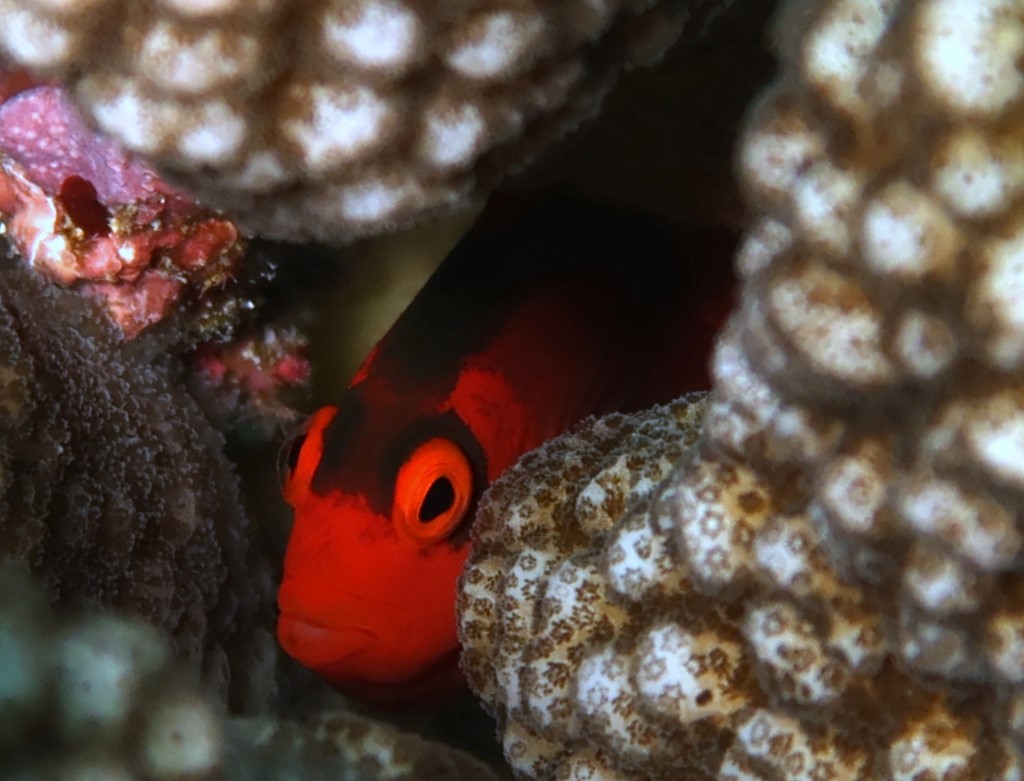NEOCIRRHITES ARMATUS - (CASTELNAU, 1873)
Picture courtesy of: Alain Daoulas
Actinopterygii (Gigaclass) > Actinopteri (Class) > Teleostei (Subclass) > Centrarchiformes (Order) > Cirrhitioidei (Suborder) > Cirrhitidae (Family) > Neocirrhites (Genus)
Poisson-faucon flamme, Flame hawkfish, Brilliant red hawkfish, Red hawkfish, Feuer-Korallenwächter, Benigonbe, ベニゴンベ,
Synonymes
Cirrhites melanotus (Günther, 1874)
Neocirrhitus armatus (Castelnau, 1873)
-----------------------
Description
Dorsal spines (total): 10; Dorsal soft rays (total): 13; Anal spines: 3; Anal soft rays: 6-7 (usually: 7); Lower 6 pectoral rays unbranched; Lateral line scales: 42-45; Four rows of large scales above lateral line (in middle of body); Small scales on cheek in more than 12 irregular rows; Palatine teeth absent; Body depth: 2.0-2.4 in SL; A tuft of cirri from membrane near tip of each dorsal spine; Caudal fin slightly rounded. Max. length: 9.0 cm TL. Depth range: 1 - 10 m.
Color
Bright red with a dark brown band along back and base of dorsal fin and a dark brown blotch behind and adjacent to eye.
Etymology
Neocirrhites: from Greek, neos = new + + from Latin, cirrus = curl, fringe.
armatus: from Latin, armō = armed with a weapon, equipped, fortified, armoured. Referring to preoperculum “armed with spines”.
Distribution
Western Pacific: Papua New Guinea, east to Line Islands (Kiribati) and Pitcairn Islands, north to Kagoshima Prefecture (southern Japan) and Ogasawara Islands (Japan), south to Great Barrier Reef/Queensland (Australia) and New Caledonia.
Biology
Common along surge-swept reef fronts and submarine terraces. Usually seen hiding among branches of live corals. Retreats deep into the coral when approached. Feeds on small crustaceans. Oviparous. Pelagic spawners. Monogamous mating is observed as both facultative and social. Highly priced aquarium fish, requires well-oxygenated water and fades in captivity.
Last update: 18, March 2023
Actinopterygii (Gigaclass) > Actinopteri (Class) > Teleostei (Subclass) > Centrarchiformes (Order) > Cirrhitioidei (Suborder) > Cirrhitidae (Family) > Neocirrhites (Genus)
Poisson-faucon flamme, Flame hawkfish, Brilliant red hawkfish, Red hawkfish, Feuer-Korallenwächter, Benigonbe, ベニゴンベ,
Synonymes
Cirrhites melanotus (Günther, 1874)
Neocirrhitus armatus (Castelnau, 1873)
-----------------------
Description
Dorsal spines (total): 10; Dorsal soft rays (total): 13; Anal spines: 3; Anal soft rays: 6-7 (usually: 7); Lower 6 pectoral rays unbranched; Lateral line scales: 42-45; Four rows of large scales above lateral line (in middle of body); Small scales on cheek in more than 12 irregular rows; Palatine teeth absent; Body depth: 2.0-2.4 in SL; A tuft of cirri from membrane near tip of each dorsal spine; Caudal fin slightly rounded. Max. length: 9.0 cm TL. Depth range: 1 - 10 m.
Color
Bright red with a dark brown band along back and base of dorsal fin and a dark brown blotch behind and adjacent to eye.
Etymology
Neocirrhites: from Greek, neos = new + + from Latin, cirrus = curl, fringe.
armatus: from Latin, armō = armed with a weapon, equipped, fortified, armoured. Referring to preoperculum “armed with spines”.
Original description: Neocirrhites armatus Castelnau 1873 - Type locality: Noble Island, Torres Strait, Queensland, Australia.
Distribution
Western Pacific: Papua New Guinea, east to Line Islands (Kiribati) and Pitcairn Islands, north to Kagoshima Prefecture (southern Japan) and Ogasawara Islands (Japan), south to Great Barrier Reef/Queensland (Australia) and New Caledonia.
Biology
Common along surge-swept reef fronts and submarine terraces. Usually seen hiding among branches of live corals. Retreats deep into the coral when approached. Feeds on small crustaceans. Oviparous. Pelagic spawners. Monogamous mating is observed as both facultative and social. Highly priced aquarium fish, requires well-oxygenated water and fades in captivity.
Last update: 18, March 2023
